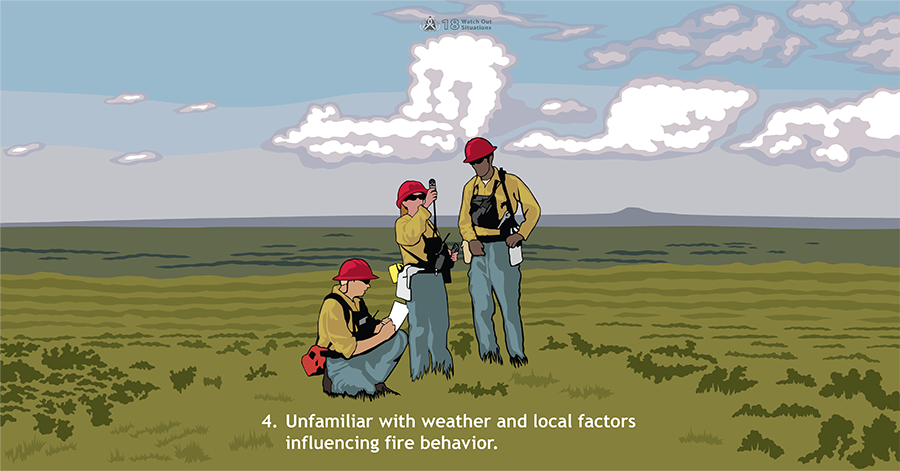
Watch Out Situation #4: Unfamiliar with weather and local factors influencing fire behavior.
What kinds of questions would you ask of local experts?
Does the operational period plan or Incident Action Plan (IAP) give you adequate weather information? What kinds of weather forecasts are available? What other weather or local information do you look for in the plan?
Can you get information from resources that have been on the fire? What questions will you ask of the crew that you are replacing?
Is there any other way to obtain information? List common sources of information on weather and local factors. Examples include web-based Weather Activity Planner, Point Forecast Matrix, National Oceanic and Atmospheric Administration (NOAA) Internet Briefing.
To Reduce Risks:
- Standard Firefighting Order #3: Base all actions on current and expected fire behavior.
- Standard Firefighting Order #4: Establish escape routes and safety zones.
- Standard Firefighting Order #5: Post lookouts.
- Discuss a fire where you relied on information from the local unit. For example, where your fire knowledge and experience were very different from how they did things—such as in the southeastern United States or Alaska.
- Recognize and report visual indicators (clouds, weather observed, cold front passage, inversion breaking).



![Standard Firefighting Order #3: Base all actions on current and expected behavior of the fire. [click to enlarge] 3. Base all actions on current and expected behavior of the fire. A firefighter looks at his watch, which reads 2 PM, while a fire actively grows in steep terrain and heavy timber.](https://fs-prod-nwcg.s3.us-gov-west-1.amazonaws.com/s3fs-public/2023-06/110-03.png)
![Standard Firefighting Order #4: Identify escape routes and safety zones, and make them known. [click to enlarge] 4. Identify escape routes and safety zones, and make them known. A fire crew is walking through a meadow on a path lined with pink flagging. Behind them, a fire is growing in heavy timber.](https://fs-prod-nwcg.s3.us-gov-west-1.amazonaws.com/s3fs-public/2023-06/110-04.png)
![Standard Firefighting Order #5: Post lookouts when there is possible danger. [click to enlarge] 5. Post lookouts when there is possible danger. A firefighter works by a water pump in a creek. Two firefighters spray water onto flames. And another firefighter talks into a radio while observing all firefighters.](https://fs-prod-nwcg.s3.us-gov-west-1.amazonaws.com/s3fs-public/2023-06/110-05.png)



